Sights
Jiayu Pass (Jiayuguan)
Updated: 2013-11-02( chinaculture.org )
The Jiayu Pass is located in the southwest of the Jiayuguan city, Gansu province.
The Jiayu Pass is not only the western end of the Great Wall of the Ming Dynasty (1368-1644), but also the vital passage of the famous Silk Road, which was first built in the 5th year (1372) of the Hongwu reign in the Ming Dynasty. It is so called because it is built at the foot of Jiayu Mountain.
The circumvallation of the Jiayu Pass looks trapeziform and there is a thick wall built outside the western circumvallation, which makes the defense of the circumvallation stronger. The circumvallation is 11.7 meters high and 733.3 meters long in total. There is an area of more than 33,500 square meters of the circumvallation. Outside the northern and southern circumvallation are parallel low cob walls, which are called the additional wall built for defense.
The city walls have two gates: the eastern one named Guanghua Gate and the western one named Rouyuan Gate, both of which have gate towers, 17 meters high, three-bay wide, with three-tiered gable and hip roof and surrounded by enclosing porches, looking grand and majestic. In the northern side inside the city walls is a wide slope horse way, directly leading to the top of the city wall. Outside the eastern and western gate, are built small enceintes of the gates. The gates of small enceintes open southwards, but are not connected with the main gates of the city walls. The eastern gate of enceinte is called Chaozong, while the western one called Huiji. More than 10 meters outside the western gate is quadrate double-barriers, side by side with the city walls, whose gate opens westwards. There is the name of the Jiayu Pass carved powerfully and vigorously on the upper part of the lintel.
Walking westwards out of the city gate, about more than 100 paces, one will see a big stone tablet on which are carved four big characters that mean impregnable pass in the world, which was set up in the Qing Dynasty (1644-1911). On the four corners of the city walls, there is a two-storeyed watchtower each, like a blockhouse. In the right middle of the northern and southern city walls is built a lookout tower each, which is two-bay wide with front porches. On the west, the south and the north sides of the additional walls also stands a watchtower each. It is said that when building the pass, workmen made a most precise estimation of materials and as a result only one brick was left. This brick is still kept on the eaves of the gate tower of the western enceinte. Outside the eastern enceinte there are some buildings such as the Wenchang Pavilion, the Guandi Temple and the Theatre Building, and inside it there is an Office of Guerrilla Warfare, which were all built in the Qing Dynasty.
After three large-scale repairs and decorations in 1950, 1957 and 1973, the Jiayu Pass took on a new look as an impregnable pass. Many visitors come to the Jiayu Pass to cherish the memory of the past.
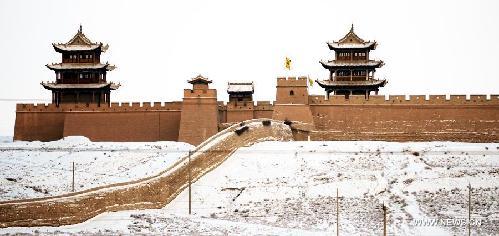 |
|
Photo taken on Dec. 21, 2012 shows the Jiayu Pass after snowfall in Jiayuguan city, northwest China's Gansu province.[Photo/Xinhua]. |
 |
|
Photo taken on Dec. 21, 2012 shows a gate tower of the Jiayu Pass scenic spot after snowfall in Jiayuguan City, northwest China's Gansu Province. [Photo/Xinhua]. |
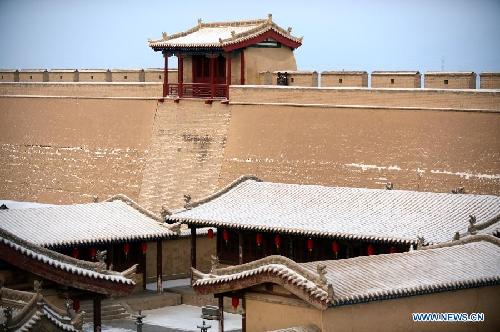 |
|
Photo taken on Dec. 21, 2012 shows a gate tower of the Jiayu Pass scenic spot after snowfall in Jiayuguan City, northwest China's Gansu Province.[Photo/Xinhua]. |
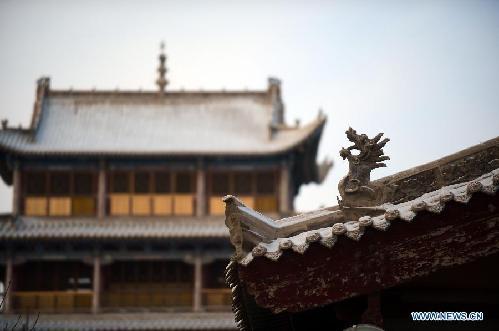 |
|
Photo taken on Dec. 21, 2012 shows a gate tower of the Jiayu Pass scenic spot after snowfall in Jiayuguan City, northwest China's Gansu Province.[Photo/Xinhua]. |
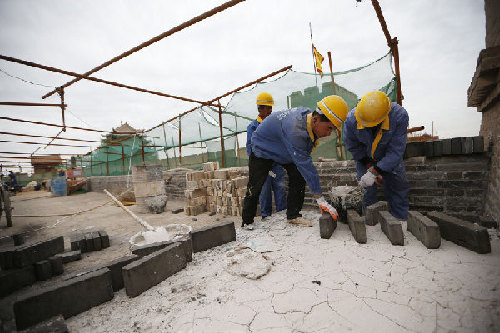 |
|
The Jiayu Pass is the western terminus of the Ming Dynasty (1368-1644) Great Wall. It's the bulwark's best-preserved military fortress from any period, and contains a moat and inner and outer cities. Renovations began in 2011 and are expected to wrap up in 2014.[Photo by Chen Xi/China Daily] |
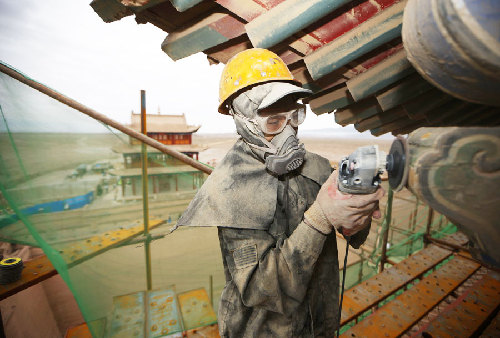 |
|
The Jiayu Pass is the western terminus of the Ming Dynasty (1368-1644) Great Wall. It's the bulwark's best-preserved military fortress from any period, and contains a moat and inner and outer cities. Renovations began in 2011 and are expected to wrap up in 2014.[Photo by Chen Xi/China Daily] |


